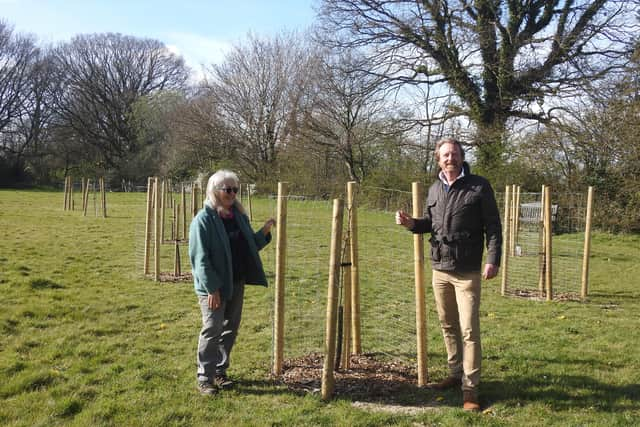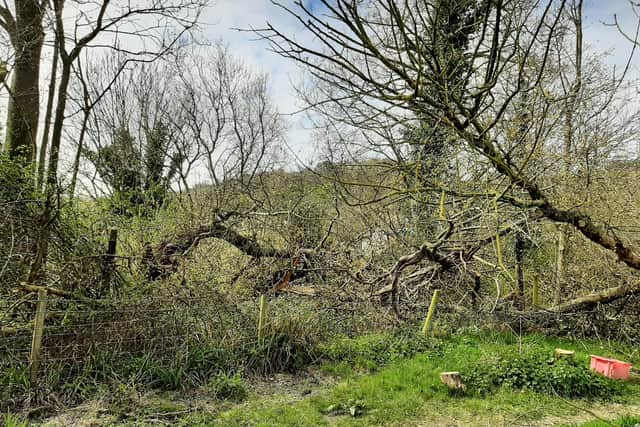This is why Horsham football club - and roadside verges - could help protect wildlife
and live on Freeview channel 276
Experts say that roadside verges and green spaces are also important in enhancing the district’s environment by allowing grass to grow longer and wild flowers and pollinating insects to flourish.
It’s all part of the first steps in a project aimed at creating a ‘Nature Recovery Network’ across the Horsham district.
Advertisement
Hide AdAdvertisement
Hide AdThe project is part of a five-year ‘Wilder Horsham District’ partnership between Horsham District Council and Sussex Wildlife Trust.


It is the first of its kind in the country and aims to ensure the district’s natural environment is enhanced and protected.
A project spokesperson said: “One of the main objectives of the project is to help create a Nature Recovery Network to allow species to move freely across the district.
“To facilitate this, key habitats have been identified such as chalk grassland, reed beds and lowland heath and opportunities for habitat restoration have also been identified.
Advertisement
Hide AdAdvertisement
Hide Ad“It is these habitats and areas that the project will seek to enhance, expand and connect.


“There is huge potential and variety in the sites the project has already engaged with.
“They include Horsham Football Club, where there is, quite aside from the actual football pitches, surrounding land which can be dedicated to nature recovery.
“Working farms, such as Shiprods Farm, that are looking to improve both their farming system and biodiversity value; large private estates are considering how to implement Nature Recovery Networks on their own land.
Advertisement
Hide AdAdvertisement
Hide Ad“However, it will take time for the changes that are being made to land management to create new habitats or expand existing ones. This is why Wilder Horsham District is a five-year project.”
Horsham District Council cabinet member for leisure Roger Noel said:“We really embrace this great opportunity for us to enhance the natural heritage and ecology of our district by teaming up with such a well-respected organisation as the Sussex Wildlife Trust.
“I see this partnership as a major commitment to reversing the decline of wildlife that has taken place over the last few decades.
“Despite the pandemic restrictions, we have already made great progress in engaging and actively involving local landowners and communities and already in these initial months we have started some key projects to tangibly improve the biodiversity of our landscape.
Advertisement
Hide AdAdvertisement
Hide Ad“We look forward to the ongoing support of residents, businesses and landowners to achieve the project’s ambitious aims and make a real difference for nature.”
Sussex Wildlife Trust chief executive Tor Lawrence said: “We’re really delighted that, despite the pandemic, the enthusiasm of landowners and communities has meant the Wilder Horsham District project has got off to a great start.
“We’re looking forward to the project helping develop connect nature and habitats across the district.”
A Volunteer Force has recently been launched to encourage people to support the project. After training, volunteers can help with practical tasks and those with specialist knowledge can get involved in surveying sites to identify which plants and animals are present.
Advertisement
Hide AdAdvertisement
Hide AdThe Wilder Horsham District team is working closely with the district council to also look at improvements in land management across council-owned land as, they say, this is also a key part of creating a Nature Recovery Network.
All the countryside sites are principally managed for their wildlife value and this is reflected, they say, in the fact that Warnham Local Nature Reserve, Chesworth Farm and Southwater Country Park are all designated as Local Wildlife Sites, with significant ecological value - and Monkmead Woods is a Site of Special Scientific Interest.
The council’s warden team carry out a range of practical habitat management work, as well as wildlife surveys to understand how rich the sites are for nature. The council also relies on many thousands of hours of volunteer input to support this work, as well as using cattle and sheep to graze some of its grassland.
The council is currently in the process of reviewing its grounds maintenance tender and is enhancing town centre parks and local greenspaces by changing mowing regimes where possible to create areas of longer meadow grass and encourage wildflowers.
Advertisement
Hide AdAdvertisement
Hide AdIt is also minimising use of herbicides and encouraging plant suppliers to swap to non-peat based compost if they don’t already use them.
Seasonal planting is also being reduced and more perennial, pollinator-friendly planting is being introduced.
Meanwhile, stumps of felled trees are being left to create a dead-wood habitat for beetles and other insects.
A Nature Recovery Award has been set up which offers funds to landowners and community groups who want to set up or improve networks for wildlife.
See sussexwildlifetrust.org.uk/get-involved/community-projects/wilder-horsham/nature-recovery-award